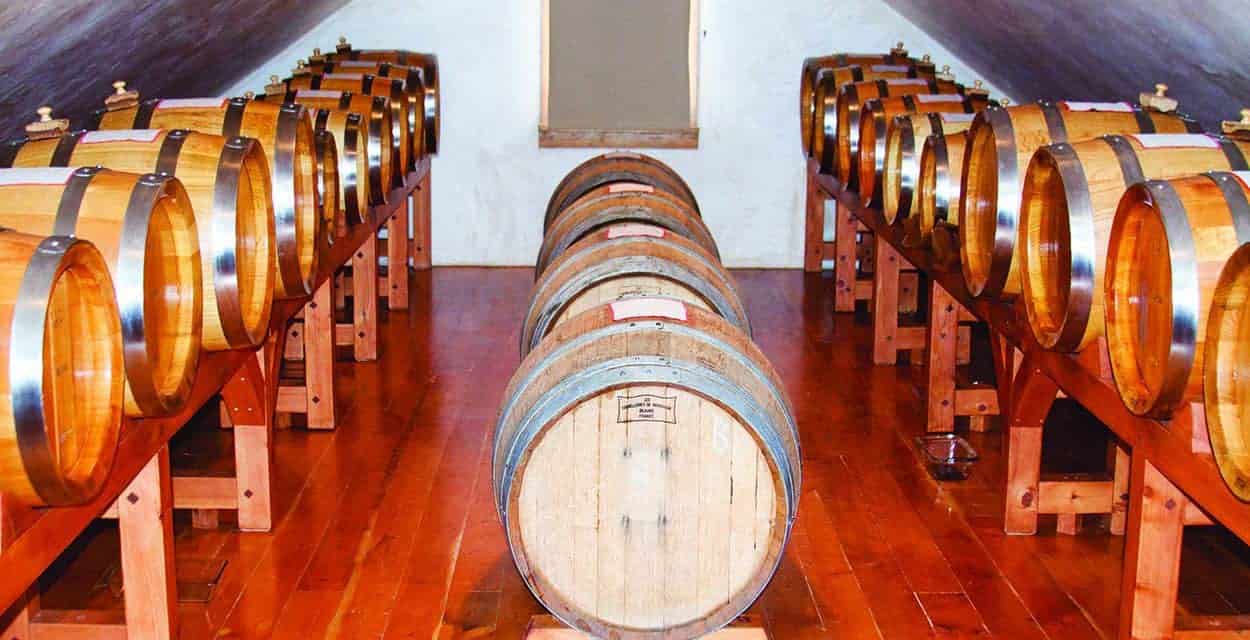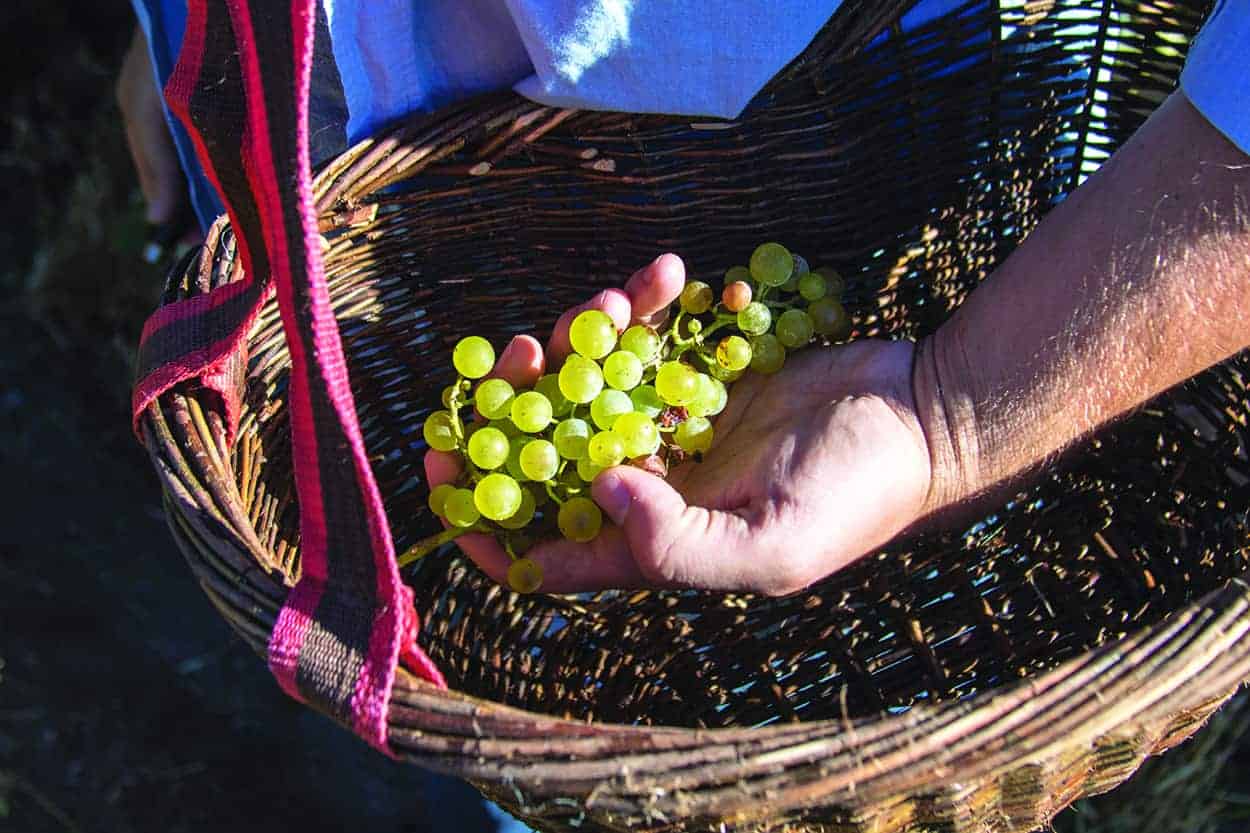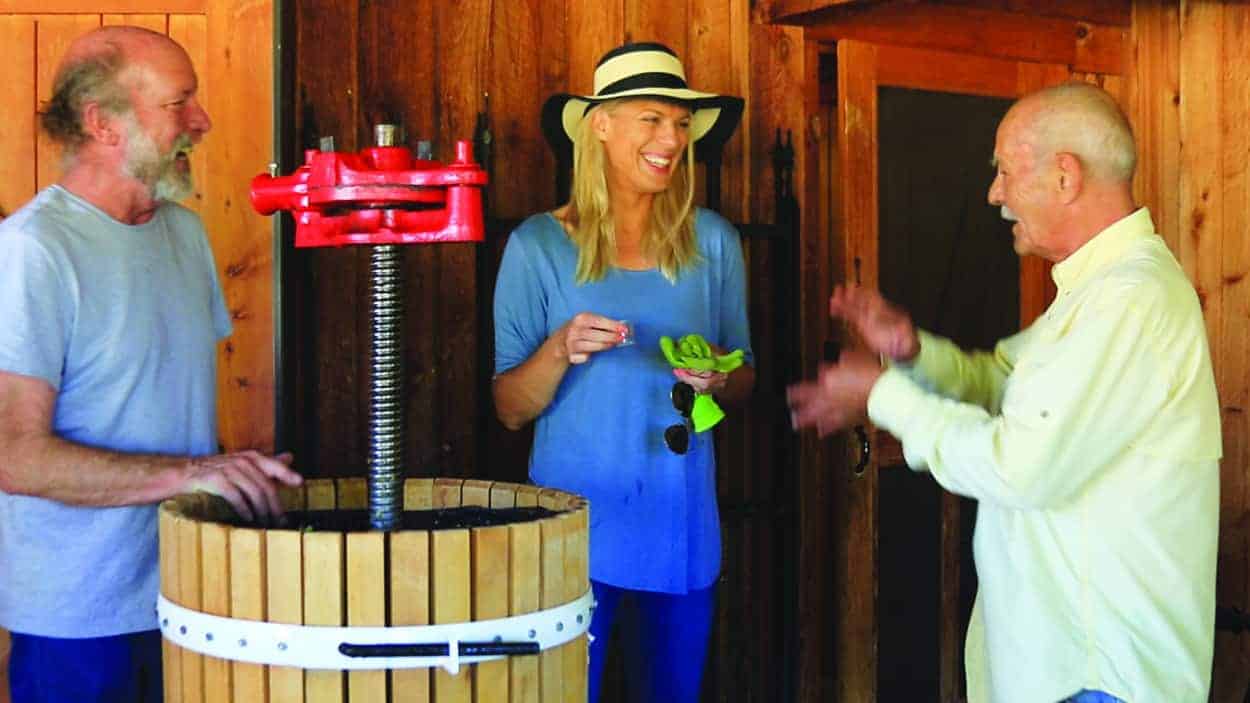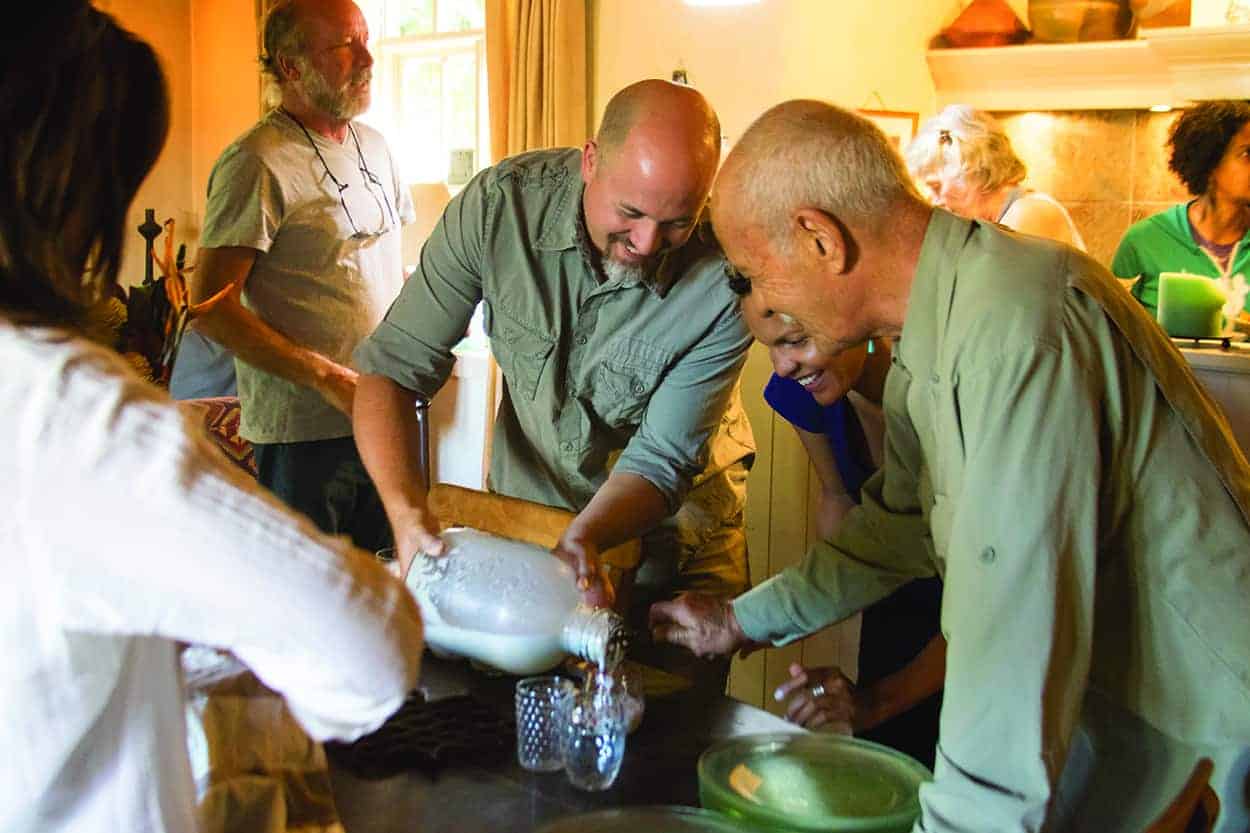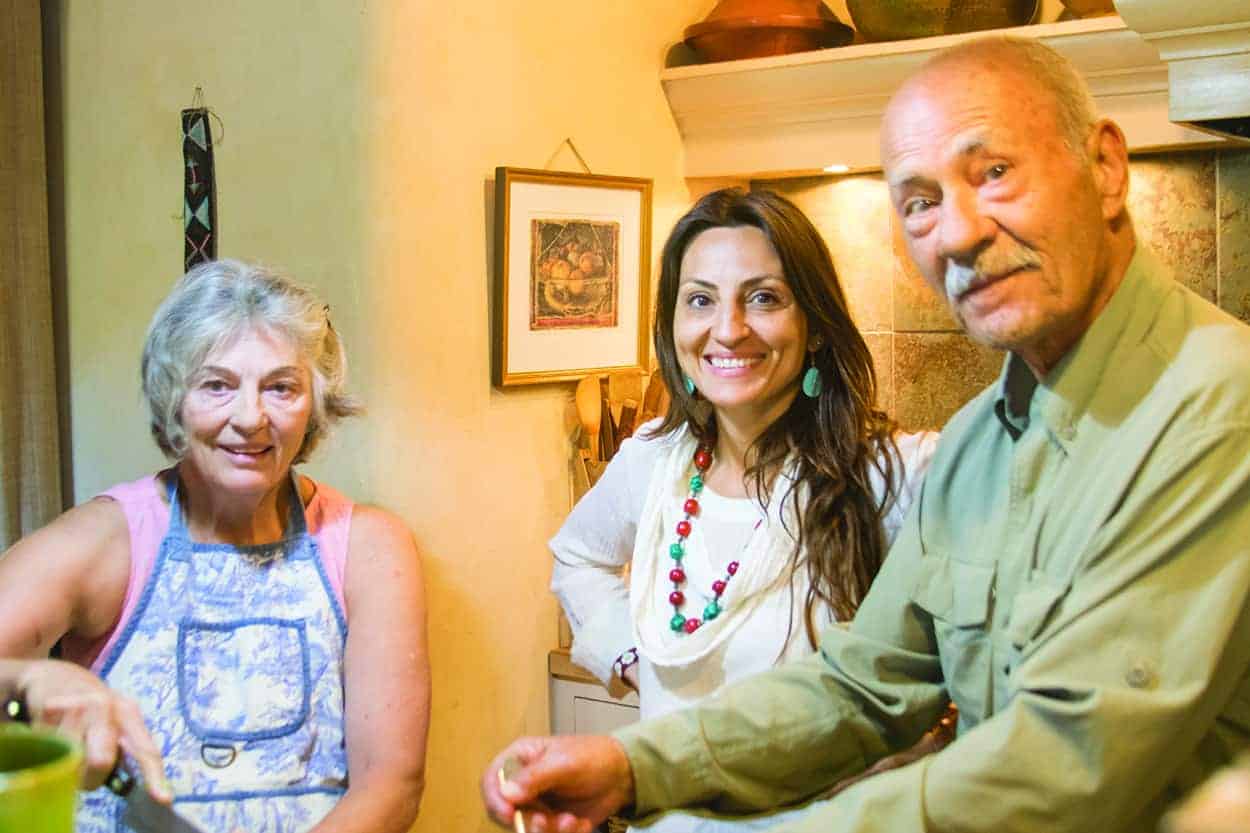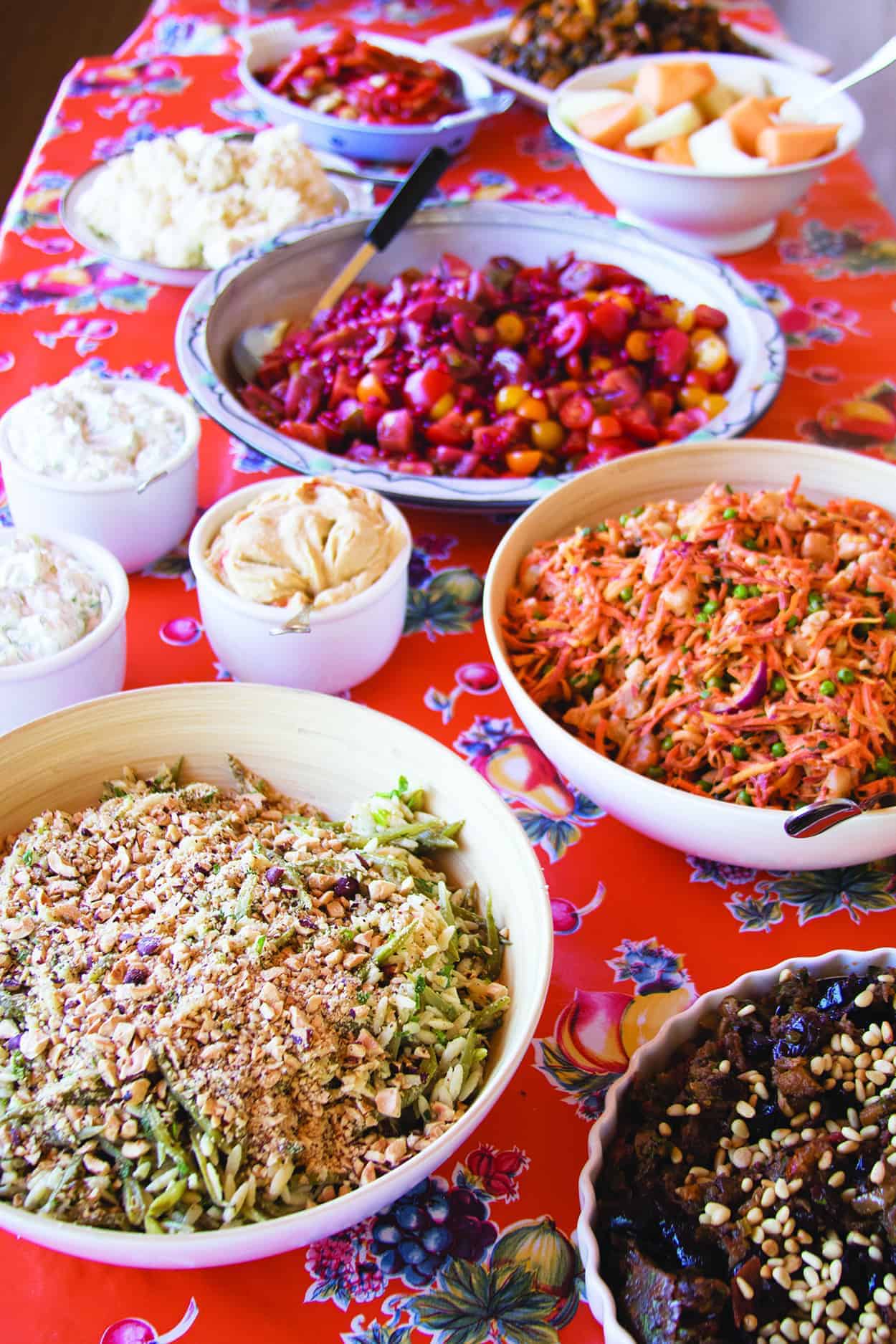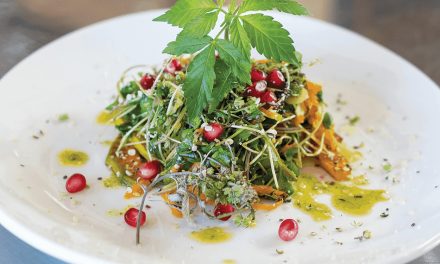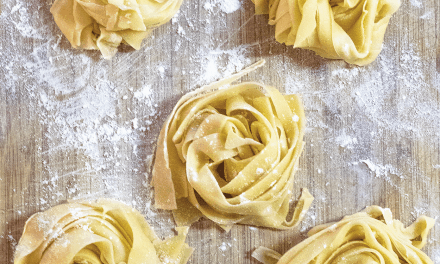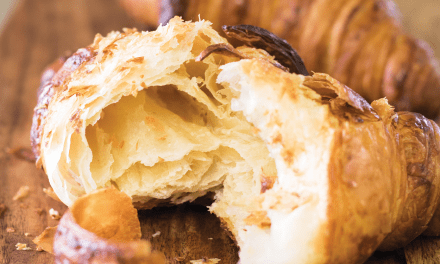
by Sarah Wentzel-Fisher
Like the warm spring that feeds a perennial acequia through the Alamosa Creek Canyon, Jane and Steve Darland are a wellspring of craftsmanship, ideas, humor, and hospitality, fostering agriculture and community in the village of Monticello. On a bright day in September, Stephanie Cameron and I headed south to join the Darlands at their home and farm for the annual grape crush. Every year, close to the autumnal equinox, the Darlands, proprietors and producers of Aceto Balsamico of Monticello, invite a team of friends and family to pick and process grapes, to share in lively conversation around their table and in their gardens, and to break bread with them in celebration of the harvest. Over the course of two and a half days, we got a rare insider’s view of one of the critical steps in making balsamic vinegar. We also made new friends and began to understand more deeply the relationship between taste and time.
The grape crush provides the juice to feed the slow process of making balsamic vinegar, but it also nurtures a critical kind of community building that only these types of labor-intensive, multi-year projects can. The Darlands harvested their first grapes in 1997 and have enlisted support in the process ever since. Balsamic vinegar made in the tradition of Modena and Reggio Emilia, aged and evaporated in sequential wood barrels, comes of age at twelve years, after which it can be classified and labeled as traditional. This label may have as much to do with the people who come back year after year to participate, as with the vinegar.
Shortly after our arrival, other guests and neighbors appeared, and conversation turned to preparation for harvest and speculation on who else would attend from years past. The first step was to remove row covers from the vines. Steve gave assignments, and, with the flourish of a master orator, embellished mundane tasks, like moving large storage containers, with stories, interesting grape and vinegar facts, and the occasional wry joke. Some pickers have attended the grape harvest for years; others, like Stephanie and I, were first-timers. While most who have helped before know the steps, everyone listened carefully to Steve. His presentation on how we would remove the cloth covering the ripe fruit to protect it from birds, bees, and hungry raccoons and skunks is part of the story and process of how these Trebbiano and Occhio di Gatto grapes become balsamic vinegar.
In teams of two and three, we removed covers from vines laden with pungent fruit, then packed the cover materials into the storage barrels where they would stay until next fall. Many hands made short work, and the team celebrated a successful first step with libations and a walk before dinner. The next morning we would start picking early, but for this evening, we would eat and rest and enjoy one another’s company. In an era when so much of our food production is automated, from harvest to processing to cooking, it’s easy to forget the beauty of the slow and handmade. Tasks like making balsamic vinegar can be done with machines (most of the balsamic sold in the United States is dubbed industriale by the Italians who make and ship it to us, but do not use it; it’s actually illegal to label it “balsamic” in Italy since it’s just a mix of red wine vinegar and dark, thick sweeteners), but the conversation and all the food prepared to feed those who have worked wouldn’t be necessary—and so much more would be lost.
While we uncovered grapes, Jane, her daughter Amy, and others wandered in and out of her kitchen, together preparing a simple, substantial, delicious meal—perfect for field work—comprised of a salad from her garden and a lasagna large enough to feed twice as many people as would eat. At a long table on a screened veranda, we ate and told more stories. We met a couple who had reconnected forty years after a teenage romance, only to find they were still madly in love; locals who raised pigs and eggs; and a family visiting from California. Convening neighbors from the village and visitors from afar provided fresh ideas and perspective for those who live there, and inspired commitment and investment from those who only visit occasionally. While Monticello is small (one hundred fifty people, including the town and canyon), this tradition brings people together, and has kept Monticello vibrant and captivating.
In the morning, we assembled on the hillside above the vineyard, and again Steve talked us through the process while we listened and watched as if he were performing magic tricks. Armed with roncolas (curved pruning knives), we moved into the vines with baskets hung around our necks. We cut grapes and loaded our baskets, taking turns to unload and carry them out to larger crates for transport to the patio below the acetaia, or acid house, a large building on the north edge of the vineyard. Our hands patinaed with sugar and dust, we chatted for several hours between the vines and leaves, getting to know one another directly or by eavesdropping on the conversation a row over. Well before noon, we had cleaned the vines of their fruit—this year, about 2,500 pounds. As we moved to the next phase, Steve shared details about how this year’s harvest measured up. The yield was lower than in years past, probably due to the very hot summer, but the sugar content of the grapes was high—and when making balsamic, it’s all about the sweetness.
The acetaia, on its second floor, houses the batteria: a dozen sets of barrels, seven or eight in each, where the Darlands’ vinegar patiently ferments and transpires. Below, a cold room and storage area house all the processing equipment needed for the crush. Steve had assembled the destemmer, a juice press, and a series of large stainless steel pots over large propane burners. A team loaded grapes first into the destemmer, then into the press. With Steve’s encouragement, everyone tasted a bit of the first juices, the mosto, from the press, which comes primarily from the intermediate membrane of the grape between the skin and the inner seed sac. Once extracted, the juice would sit overnight in a cold walk-in refrigerator to allow sediment to settle, before teams transferred the juice to the large steel vats.
Again, while the field crew worked, some made their way into the kitchen to assist Jane in assembling a mezze lunch of so many different dishes that sampling them all was nearly impossible. Appetites whetted from work, the team loaded plates and settled on the lawn, patio, and veranda of a guest house for lunch and more conversation about how this year measured up.
Steve explained that the high sugar content of this year’s grapes would make up for the lighter yield because the juice would need to be reduced less to get the sweetness required for the growth of the microorganisms that transform the mash to vinegar. The next step would involve reduction of the juice, over a number of days, to exactly the right brix (sugar content) level. At this point in the process, it has become mosto cotto, a thicker syrup that will be inoculated with a special blend of yeast and bacteria to start the fermentation process.
By mid-afternoon, tired, full, and warm, we dispersed to our separate quarters for a short siesta, then made our way in small groups to the center of Monticello to appreciate the place that inspires the making of the delicate nectar that is Aceto Balsamico of Monticello. Carefully restored houses line the small park plaza at the center of town, but the landscape is also marked with dilapidated buildings of eras past—perhaps the most poignant being a Depression-era schoolhouse with elm trees rooted in cellar soil and branches extending to form the building’s only roof. This place, once home to enough young families to fill several classrooms, had, like the Darlands’ vinegar, changed over decades into something punctuated by a different character of community.
We gathered twice more to celebrate the twentieth successful harvest, first for an evening meal of leftovers, then for a Southwest-inspired brunch. For each meal, the number of chairs at the table decreased and, like balsamic, the team slowly evaporated. The next few years will mark a new level of maturation of the Darlands’ balsamic, and the process and people involved in making it. After most have headed home, Steve and a few remaining guests will move the mosto cotto into carboys where it will further settle until February, when he will perform the rincalzo, or topping off of the barrels where the balsamic ages.
As we said our goodbyes, Steve described a visit to Italy to taste balsamics. On this visit, he tasted a balsamic dating back to the 1660s (balsamic vinegar was first described in a papal document in 1046). Apparently, it tasted terrible. Since then Italy has been fraught with political unrest, a civil war, a bubonic plague epidemic, and two world wars. Perhaps these hardships helped build character in the region, and that is reflected somehow in the pungency of their vinegar. As we drove back toward Albuquerque through blooming chamisa under a cloudless sky, I daydreamt about how the quality of our conversations and the food we shared will impact the flavor of the future’s Aceto Balsamico of Monticello. I hope it will taste like love and laughter, a sweet and deep note on the back of the tongue.
Edible celebrates New Mexico's food culture, season by season. We believe that knowing where our food comes from is a powerful thing. With our high-quality, aesthetically pleasing and informative publication, we inspire readers to support and celebrate the growers, producers, chefs, beverage and food artisans, and other food professionals in our community.

